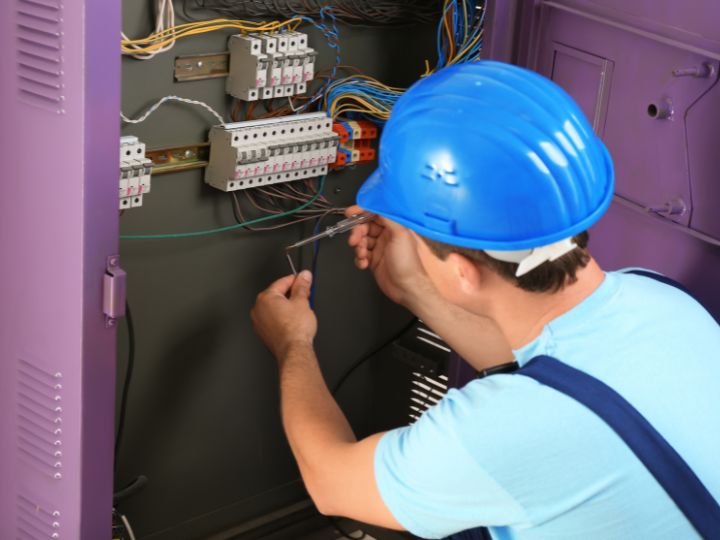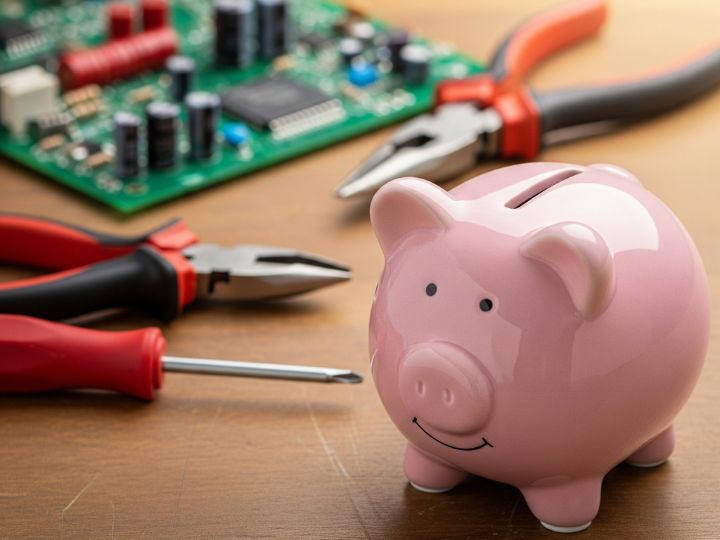Preventive electrical maintenance is a proactive, cost-effective strategy that involves routine inspection, testing, and servicing of electrical systems to avoid unexpected failures. Unlike reactive maintenance—where repairs happen after issues arise—preventive care identifies and resolves potential hazards before they escalate into major problems.
Whether you’re a homeowner, property manager, or business owner, implementing a regular preventive maintenance plan can significantly reduce repair costs, enhance safety, and extend equipment lifespan. In this guide, the licensed professionals at Electricians Service Team explain how this proactive approach delivers lasting financial, operational, and environmental benefits.
Reduction in Costly Emergency Repairs

Emergency electrical failures often come with a hefty price tag—premium service rates, after-hours surcharges, and the cost of urgent equipment replacements. Common emergency issues include:
- Sudden panel malfunctions
- Wiring faults
- Overloaded circuits
By identifying early warning signs like loose connections or overheating equipment, preventive maintenance eliminates the need for expensive emergency interventions. Regular inspections allow minor issues to be resolved before they lead to system-wide failures.
Extended Lifespan of Electrical Equipment
Electrical systems naturally degrade due to dust buildup, corrosion, and thermal stress. However, consistent maintenance helps extend the useful life of:
- Transformers
- Switchgear
- Breakers
- Wiring systems
Through cleaning, lubricating, tightening, and testing, these components stay within optimal operating conditions. This means delayed equipment replacement, protecting your capital investment.
Increased Energy Efficiency and Lower Utility Bills
Faulty electrical systems waste energy. Loose connections, unbalanced loads, and aging motors all contribute to excess energy consumption. Preventive maintenance includes load testing, power quality analysis, and thermal imaging, which can detect inefficiencies that aren’t visible to the naked eye.
When systems run efficiently, energy consumption drops—especially when aligned with best practices from resources like the U.S. Department of Energy. Businesses and property owners that perform consistent electrical upkeep often see noticeable reductions in their monthly electricity bills. This directly impacts operating expenses and supports broader sustainability goals.
Improved Safety and Reduced Liability Risks
Neglected electrical systems pose significant safety risks. Arcing, short circuits, exposed wires, and overloaded circuits can all lead to fires, electrical shocks, and equipment failure. These dangers not only jeopardize human lives but can also result in massive financial liability, legal issues, and reputational damage. Failing to address the warning signs your circuit breaker needs repair is one example of how small oversights can lead to big problems.
Preventive maintenance programs reduce these risks by ensuring all equipment is OSHA-compliant and operating safely. Infrared scanning can identify hot spots before they ignite. Ground-fault protection and insulation testing further guard against failures. A consistent maintenance record also strengthens a company’s defense in liability claims and insurance audits.
Minimized Operational Downtime
Unexpected electrical failures bring operations to a standstill. For factories, data centers, retail stores, and office buildings, every minute of downtime equates to lost productivity, disrupted services, and frustrated customers.
A preventive electrical maintenance plan ensures that critical systems are continually monitored and optimized, drastically reducing the chances of unexpected interruptions. Scheduled downtime for maintenance is always more manageable than dealing with the fallout of an unplanned power outage or system failure.
Compliance with Industry Standards and Regulations
Many industries—especially healthcare, manufacturing, and hospitality—are governed by strict electrical safety regulations, such as NFPA 70B, OSHA, and NEC codes. Failing to meet these standards can result in heavy fines, shutdowns, or loss of accreditation.
Regular maintenance checks ensure that all systems remain in compliance, helping organizations avoid regulatory penalties and maintain uninterrupted operation. In many cases, having documented maintenance procedures is a legal requirement for operating permits or insurance policies.
Enhanced Asset Management and Budget Predictability
Preventive maintenance enables smarter asset management. Through detailed inspection logs and testing data, facility managers gain valuable insights into the condition and performance of their electrical systems. This data-driven approach allows for accurate forecasting of repairs and replacements, eliminating budget surprises.
Moreover, organizations can spread maintenance costs over time, rather than facing large, unplanned expenditures. Predictable costs mean better budget control, improved ROI, and peace of mind for property owners and stakeholders.
Boosted Property Value and Marketability
For commercial and residential properties alike, well-maintained electrical systems are a major selling point. Prospective buyers and tenants are more likely to invest in properties with a history of regular electrical upkeep.
By demonstrating that your electrical infrastructure is modern, safe, and energy-efficient, you enhance your property’s overall value and market appeal. Buyers understand that preventive maintenance reduces the likelihood of future repairs, offering long-term cost savings and convenience.
Environmental Benefits from Efficient Systems
Sustainable business practices are no longer optional—they’re expected. Preventive maintenance helps minimize energy waste, reduce carbon emissions, and extend the lifespan of electrical assets, contributing to a lower environmental footprint.
By embracing energy-efficient operations and responsible equipment management, organizations showcase their commitment to sustainability. This not only benefits the planet but also enhances brand image, customer loyalty, and corporate social responsibility (CSR) ratings.
Critical Tasks Included in Preventive Electrical Maintenance
A robust preventive maintenance plan includes the following tasks:
- Visual inspections of switchgear, circuit breakers, outlets, and lighting
- Thermal imaging scans to detect overheating or imbalance
- Tightening of connections to prevent arcing and voltage drops
- Insulation resistance testing for wires, transformers, and cables
- Load balancing and harmonics analysis to ensure system stability
- Cleaning and lubrication of motor components and switchboards
- Function testing of safety devices, such as GFCIs and AFCIs
- Documentation and reporting for compliance and audit trails
Regularly scheduled and professionally executed, these tasks—along with safety inspections and troubleshooting—are vital to keeping electrical systems in optimal condition.
Why Hire a Professional Electrician for Preventive Maintenance?
Entrusting preventive electrical maintenance to professionals ensures your system gets the specialized care it needs. The Electricians Service Team delivers precise diagnostics, thorough inspections, and reliable solutions that go beyond DIY fixes—keeping your property safe and up to code.
Professional electricians provide:
- Certified inspections using advanced diagnostic tools
- Detailed reports to support insurance or regulatory compliance
- Timely maintenance tailored to your usage patterns
- Compliance with NFPA, NEC, and OSHA standards
Ready to protect your home or business? Call the trusted experts at Electricians Service Team today for professional preventive maintenance you can count on.
Conclusion: Long-Term Financial and Operational Rewards

Investing in preventive electrical maintenance isn’t just about preventing problems—it’s about unlocking long-term financial and operational rewards. By staying ahead of potential issues, property owners can extend equipment lifespan, reduce downtime, and dramatically cut energy waste. Most importantly, it ensures a safer environment for everyone involved.
While the cost of electrical preventive maintenance may seem like an upfront expense, it pays for itself through reduced emergency repairs, lower utility bills, and regulatory compliance. Partnering with trusted professionals from Electricians Service Team ensures you get maximum value—and peace of mind—out of every inspection.
FAQs
Preventive electrical maintenance involves regularly inspecting and servicing electrical systems to prevent failures. It improves safety, reduces repair costs, and extends equipment life.
Most experts recommend scheduling maintenance annually, though high-use systems may need more frequent checks. A licensed electrician can help determine the best schedule for your needs.
Yes, it can—by identifying and correcting issues like loose connections or inefficient equipment, systems run more efficiently. This reduces wasted energy and cuts monthly utility costs.
In many industries, compliance with safety codes like NFPA 70B or OSHA mandates regular electrical maintenance. Even in residential settings, it’s often required for insurance and safety certifications.
Only qualified, licensed electricians or trained technicians should handle electrical maintenance tasks. They have the tools and expertise to safely identify issues and ensure code compliance.





